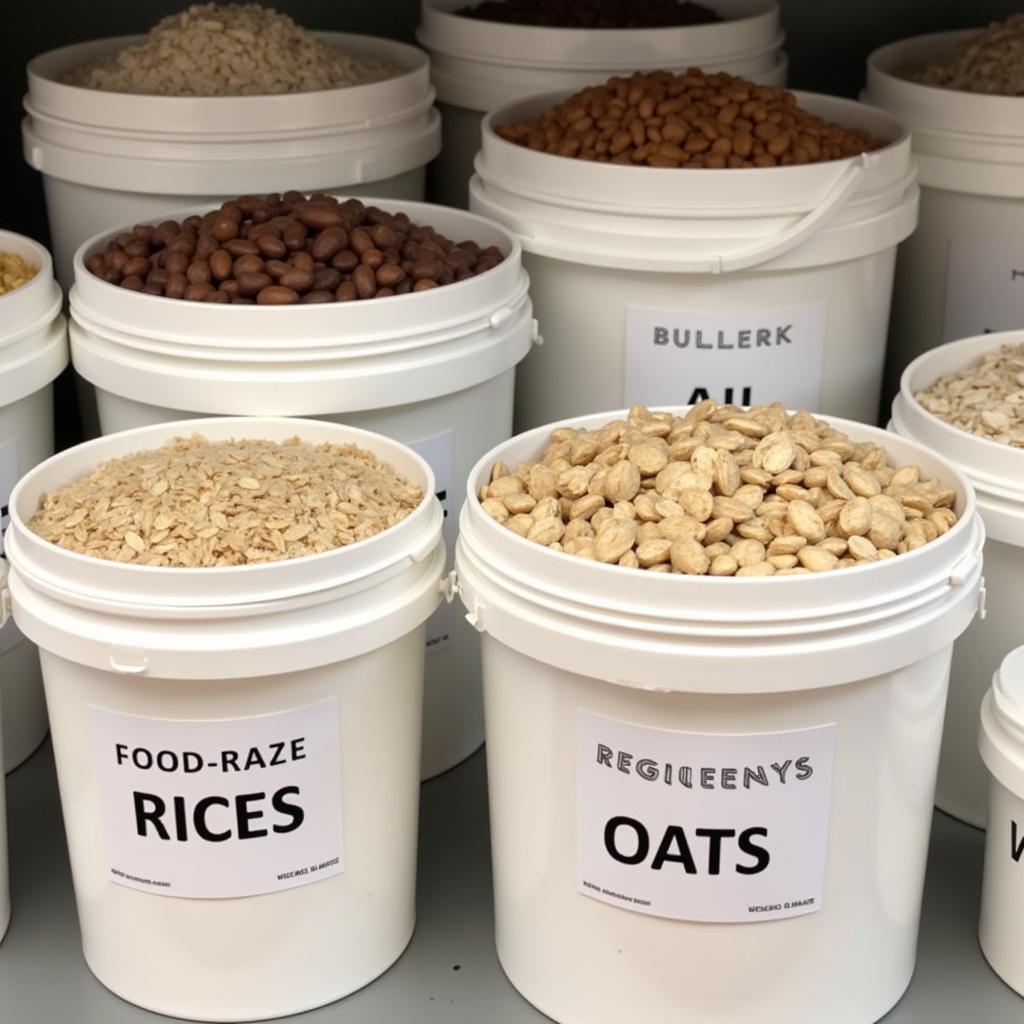Bucket Food Storage has become increasingly popular for its practicality and cost-effectiveness. But what exactly is it, and how can you make the most of it to keep your pantry stocked and your food fresh? This comprehensive guide dives deep into the world of bucket food storage, providing you with all the information you need to get started.
Why Choose Buckets for Food Storage?
 Food Grade Buckets for Long-Term Storage
Food Grade Buckets for Long-Term Storage
Unlike flimsy bags or containers that easily allow air and moisture to seep in, buckets provide an airtight and moisture-resistant environment. This helps prevent spoilage, keeps pests at bay, and ensures your food stays fresh for longer periods. Plus, they’re stackable, durable, and easy to label, making them ideal for organizing your pantry and maximizing storage space.
Choosing the Right Buckets for Food Storage
Not all buckets are created equal when it comes to food storage. Opt for 2.5 gallon food grade bucket or 3.5 gallon food grade bucket, which are made from high-density polyethylene (HDPE), a food-safe plastic that won’t leach harmful chemicals into your food. These buckets are also typically white or opaque, preventing light from degrading the quality of your stored goods.
What Foods Can You Store in Buckets?
Bucket food storage is incredibly versatile and works well for a wide range of staples, including:
- Grains: Rice, oats, quinoa, wheat, cornmeal
- Legumes: Beans, lentils, chickpeas, peas
- Nuts and Seeds: Almonds, walnuts, chia seeds, flaxseeds
- Dried Goods: Pasta, flour, sugar, powdered milk
- Other: Salt, spices, pet food, dehydrated fruits and vegetables
Essential Supplies for Bucket Food Storage
- Food-Grade Buckets: As mentioned earlier, opt for HDPE buckets with airtight lids.
- Mylar Bags: These provide an extra layer of protection against oxygen and moisture.
- Oxygen Absorbers: These small packets absorb oxygen from the air inside the bags, preventing oxidation and spoilage.
- Permanent Marker: Use this to label your buckets with the contents and storage date.
- Measuring Cups and Scoops: Helpful for portioning food when storing and using.
Steps for Packing Food in Buckets
- Clean and Dry Your Buckets: Thoroughly wash and dry your buckets before using them.
- Add Oxygen Absorbers: Place the appropriate number of oxygen absorbers inside the mylar bags.
- Fill the Bags: Fill the bags with your chosen food items, leaving some headspace at the top.
- Seal the Bags: Use a heat sealer or an iron to seal the mylar bags tightly.
- Place Bags in Buckets: Carefully place the sealed bags inside the buckets.
- Seal the Buckets: Secure the lids tightly onto the buckets.
- Label and Store: Clearly label each bucket with its contents and the storage date. Store in a cool, dry, and dark place.
Tips for Maximizing Food Freshness and Longevity
- Start with Fresh Ingredients: Always use the freshest ingredients possible for long-term storage.
- Properly Date Your Buckets: This helps you rotate your stock and use older items first.
- Inspect Regularly: Check your buckets periodically for any signs of damage, pests, or spoilage.
- Cool, Dry, and Dark Storage: Find a suitable storage location that’s away from direct sunlight, heat sources, and moisture.
“Proper food storage isn’t just about organization; it’s about preserving the integrity and flavor of your food for as long as possible,” says renowned food preservationist, Emily Carter.
FAQs about Bucket Food Storage
Q: How long can you store food in buckets?
A: Storage times vary depending on the food type. For instance, properly stored grains can last for several years, while legumes have a shorter shelf life.
Q: Do I need to use oxygen absorbers?
A: Oxygen absorbers are crucial for long-term food storage, as they significantly extend the shelf life of your food by preventing oxidation.
Q: Can I store liquids in food-grade buckets?
A: While you can store some liquids in food-grade buckets, it’s not recommended for long-term storage. Liquids are best stored in dedicated containers designed for that purpose.
Need more help with your food storage journey? Check out these resources on our website:
Embrace the Benefits of Bucket Food Storage
By following these tips and techniques, you can confidently embark on your bucket food storage journey and enjoy the peace of mind that comes with a well-stocked pantry and the ability to preserve your food’s freshness for years to come. Remember, proper bucket food storage is an investment in your family’s well-being and preparedness.
For any questions or assistance, please contact us at Phone Number: 02437655121, Email: [email protected] or visit us at 3PGH+8R9, ĐT70A, thôn Trung, Bắc Từ Liêm, Hà Nội, Việt Nam. We’re here to support you 24/7.